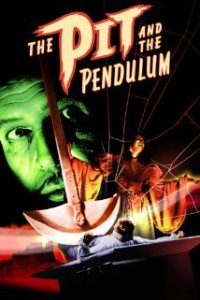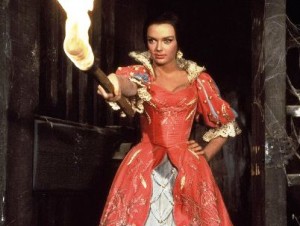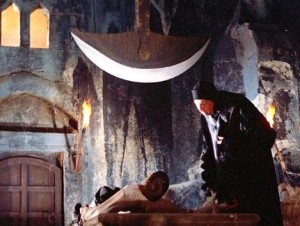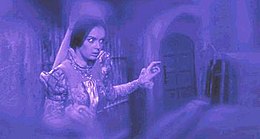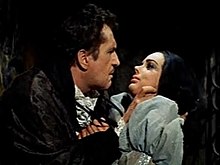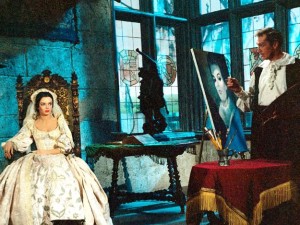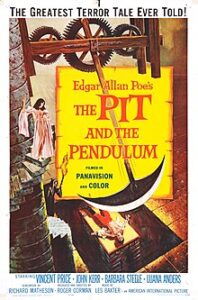The Pit and the Pendulum **** (1961, Vincent Price, Barbara Steele, John Kerr, Luana Anders) – Classic Movie Review 2845
The 1961 horror film The Pit and the Pendulum is directed by Roger Corman in Panavision and Pathécolor, and stars Vincent Price, Barbara Steele, John Kerr and Luana Anders. It is notable for Corman’s experiments with camera work and cutting, Richard Matheson’s elaborate script, Floyd Crosby’s widescreen cinematography, its great sets designed by Daniel Haller and its score composed by Les Baxter, as well as especially for Vincent Price’s gleefully maniacal star performance. That is a lot to be notable for.
Director Roger Corman’s second successful raid on the Gothic horror stories of Edgar Allan Poe after 1960’s House of Usher [The Fall of the House of Usher] finds Vincent Price again on his inspired best form, a delightful hammy and campy tour-de-force that still fits snugly into the film’s haunted atmosphere.
He plays the tremendously tormented Don Nicholas Medina, imagining he is his dead father, Sebastian, a particularly sadistic Spanish Inquisition torturer.

Handsome young John Kerr gives rather wooden performance in the unrewarding part as the as the film’s nominal hero, the innocent young English aristocrat Francis Bernard, who comes to Price’s mysterious castle on the hill in Spain to investigate the death of his sister Elizabeth (Barbara Steele) in her husband Price’s torture chamber.
Corman whips up plenty of quickly shot (15 days), low-budget ($300,000) horror, which may seem tame now. But this eerie 1961 cult midnight movie continues to keep its hold over audiences through Price’s priceless performance and the movie’s still creepy atmosphere of decadence and corruption.
The pendulum is made out of wood and has a rubber blade. However, Kerr was still wary about being strapped down to the table with the pendulum above him for the movie’s climax so Corman stood in for Kerr while the scene was being set up to show it was safe. Corman took out every other frame during editing to make the blade appear to move twice as fast and look more menacing.
The prologue was added when the film was sold to TV which required a longer running time. Only Anders was still available for filming, so an extra scene of her in a madhouse was shot and tacked on as a prologue.
It was remade in 1991 by director Stuart Gordon with Lance Henriksen as The Pit and the Pendulum and in 2009 by director David DeCoteau with Lorielle New, Stephen Hansen and Bart Voitila.
Corman won his greatest acclaim with his eight movies based on the works of Poe, made through American International Pictures and mostly in collaboration with writer Richard Matheson, who here adapts Poe’s 1842 short story The Pit and the Pendulum. Corman also worked with set designer Daniel Haller and cinematographer Floyd Crosby on the series.
The other Corman Poe adaptations are: The Fall of the House of Usher (1960), The Premature Burial (1962), Tales of Terror (1962), The Raven (1963), The Haunted Palace (1963), The Masque of the Red Death (1964) and The Tomb of Ligeia (1964). All but The Premature Burial star Vincent Price.
When House of Usher was released in June 1960, its box office success surprised AIP producers James H Nicholson and Samuel Z Arkoff and they quickly ordered up a sequel. Matheson said: ‘When the first film was a hit, they still didn’t consider doing a Poe series. They just wanted another movie with a Poe title fixed to it.’ Corman felt Poe’s two strongest stories after House of Usher were The Masque of the Red Death and Pit and the Pendulum, and the producers chose the latter because ‘it was a lot more graphic and The Masque of the Red Death would have needed a dancing troupe that would have been quite expensive.’
But Price came at a price. Indeed he upped his price for the film to $125,000, plus a percentage of the profits.
Matheson devised an elaborate narrative barely resembling Poe, with only the finale similar to the original short story. Corman said: ‘The method we adopted was to use the Poe short story as the climax for a third act to the motion picture because a two-page short story is not about to give you a 90-minute motion picture. We then constructed the first two acts in what we hoped was a manner faithful to Poe, as his climax would run only a short time on the screen.’
They did the climax proud. The film’s climactic sequence in which the young Englishman becomes strapped to the titular torture device by his lunatic brother-in-law is a piece of pure Poe.
The film’s brief exterior prologue of Kerr’s arrival to the castle was filmed on the Palos Verdes coast. The rest was shot on four interior sound stages at Hollywood’s California Studios. A castle set was designed by Daniel Haller with many levels and ample space for the elaborate planned camera movements. Haller then searched the backlots and property lofts of the major studios for set units that could be rented cheaply to assemble them to form the sets he had designed. Later 20 gallons of cobwebs were sprayed throughout the castle’s sets!
Corman set aside one day of rehearsals with his cast: ‘Thanks to pre-production planning and rehearsals, there was no time wasted on the set in haggling and making decisions.’
The movie earned $2 million and was the most financially successful of all the AIP Poe films. Arkoff recalled: ‘It’s also the one I liked the best because it was the scariest. We had a wonderful piece of artwork for the poster [by Reynold Brown] as well as some great sets by Danny Haller.’
Sadly it proved to be the last notable film appearance of John Kerr’s career following film versions of Tea and Sympathy (1956) and South Pacific (1958). He was busy on TV but in the 70s he mostly moved away from acting to become a lawyer, and operated a legal practice in Beverly Hills until he retired in 2000. Kerr died of heart failure on February 2, 2013, aged 81.
Corman became convinced that Steele’s ‘thick working-class English accent’ was not blending well with the cast, so he had all of her dialogue dubbed by a different actress.
Barbara Steele (born 29 December 1937). Ironically, she was married to American screenwriter James Poe from 1969 to 1978.
Roger Corman celebrated his 90th birthday on April 5 2016. His autobiography is titled How I Made a Hundred Movies in Hollywood and Never Lost a Dime. Ron Howard was told by Corman: ‘If you do a good job on this film, you’ll never have to work for me again.’
Howard made his directing debut with the 1977 low-budget comedy action film Grand Theft Auto, after Corman let Howard direct a film if he starred in Eat My Dust!
The cast are: Vincent Price as Nicholas/ Sebastian Medina, John Kerr as Francis Barnard, Barbara Steele as Elizabeth, Luana Anders as Catherine Medina, Antony Carbone as Doctor Leon, Patrick Westwood as Maximillian, Lynette Bernay as Maria, Larry Turner as Nicholas as child, Mary Menzies as Isabella, and Charles Victor as Bartolome.
© Derek Winnert 2015 Classic Movie Review 2845
Check out more reviews on http://derekwinnert.com

